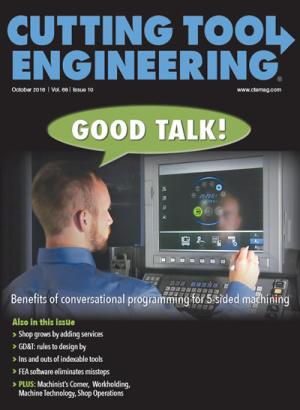IMTS 2016 featured more tools and systems for the Industrial Internet of Things (IIoT) than ever.
The interconnected production environment can significantly improve manufacturing processes and reduce costs by structuring vast amounts of data into actionable information and controlling and monitoring machining performance, via sensors, in real time on a macro or micro level.
Wow! That sounds great. And with firewalls, password protection, encryption and other security measures, what could possibly go wrong? Sure, high-profile hacking occurs, but those are isolated incidents—the result of negligent or disgruntled workers, right?
That’s pretty much the perception I had until I read Marc Goodman’s “Future Crimes: Inside the Digital Underground and the Battle for Our Connected World” from Anchor Books. Goodman, who has a background in law enforcement and technology, emphasized the tremendous amount of wealth and control hackers, terrorists and state-sponsored agents can hijack from the “old” internet that allows desktops, laptops and servers to share information, as well as the current generation of smart phones, meters and watches. But in the rapidly approaching future, all objects may become “smart” and able to communicate an array of information.
“While its multifold benefits seem manifest, an Internet of everything also poses tremendous risk,” Goodman wrote. “For just as electricity can shock and kill, so too can billions of connected things networked online.”
To learn more about IIoT’s impact in the manufacturing world, I attended a cybersecurity presentation Sept. 13 at TÜV Rheinland of North America Inc.’s IMTS booth. Nathaniel Cole, regional practice lead for TÜV’s OpenSky Corp., Tolland, Conn., emphasized that all it takes is one breach of a cybersecurity system to become a major issue. Cole gave the example of an oil rig attack in which a hacker manipulates a critical pressure to cause it to rise and manipulates the monitor so the pressure appears to be OK, enabling the pressure to rise to a level that causes massive damage to the rig and jeopardizes worker safety.
In another possible man-in-the-middle scenario, hackers infiltrate a manufacturing system for mission-critical aerospace defense parts and alter the parameters when hard turning to create a white layer that negatively impacts fatigue strength. The control and metrology systems show everything going as planned, but savvy workers might scrap a significant number of parts based on their senses, causing financial hardship for the manufacturer, or the parts might be given the green light and then fail while in operation.
Nonetheless, Cole said steps can be taken to help protect an interconnected system. These include identifying threats, testing for vulnerabilities as code is written, ensuring controls are sufficient and effective, stemming the application-exploit trend with a robust security program and progressing to more advanced techniques.
Even if it doesn’t secure 100 percent of all possible hacker-entry points, putting controls around a system may make it not worth the effort it would take a hacker to infiltrate it or enable a manufacturer to detect an intruder.
Above all, it’s essential to remain diligent about cybersecurity. “It’s always going to be an arms race,” Cole said. “Things are going to evolve to the point where what we developed a year ago may no longer be secure today, so we need to figure out how to secure it going forward.”
Related Glossary Terms
- fatigue
fatigue
Phenomenon leading to fracture under repeated or fluctuating stresses having a maximum value less than the tensile strength of the material. Fatigue fractures are progressive, beginning as minute cracks that grow under the action of the fluctuating stress.
- fatigue strength
fatigue strength
Maximum stress that can be sustained for a specified number of cycles without failure, the stress being completely reversed within each cycle unless otherwise stated.
- hard turning
hard turning
Single-point cutting of a workpiece that has a hardness value higher than 45 HRC.
- metrology
metrology
Science of measurement; the principles on which precision machining, quality control and inspection are based. See precision machining, measurement.
- turning
turning
Workpiece is held in a chuck, mounted on a face plate or secured between centers and rotated while a cutting tool, normally a single-point tool, is fed into it along its periphery or across its end or face. Takes the form of straight turning (cutting along the periphery of the workpiece); taper turning (creating a taper); step turning (turning different-size diameters on the same work); chamfering (beveling an edge or shoulder); facing (cutting on an end); turning threads (usually external but can be internal); roughing (high-volume metal removal); and finishing (final light cuts). Performed on lathes, turning centers, chucking machines, automatic screw machines and similar machines.


